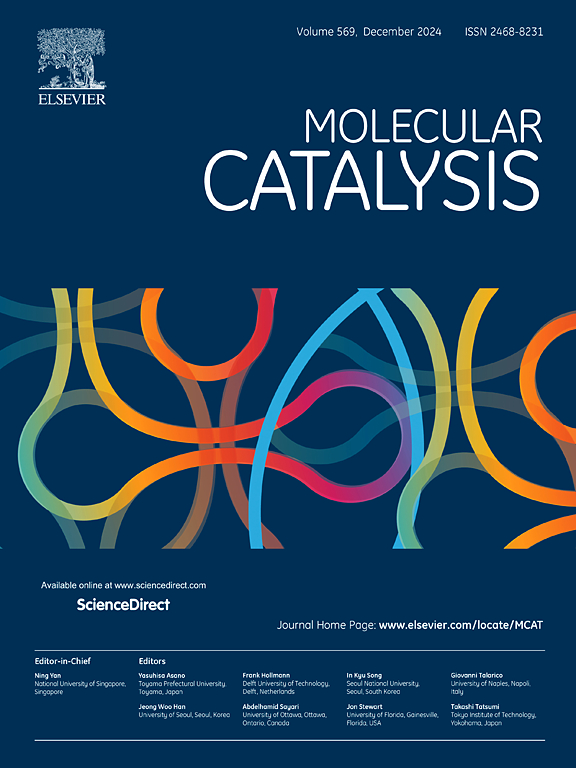in修饰NiMoS活性相对4,6-二甲基二苯并噻吩直接脱硫反应过程的影响
IF 4.9
2区 化学
Q2 CHEMISTRY, PHYSICAL
引用次数: 0
摘要
目前,非贵金属加氢脱硫(HDS)催化剂支撑NiMoS活性相形成的拐角活性位点数量有限,延展性差,大大降低了直接脱硫(DDS)和直接脱硫(HDS)性能,给超深度脱硫带来了很大的挑战。本文采用密度泛函理论计算方法探讨了单原子In启动子对活性相几何结构和电子结构的影响,研究了4,6-二甲基二苯并噻吩(4,6- dmdbt)在不同活性位点的吸附行为,并彻底阐明了这些变化对4,6- dmdbt DDS途径的影响。结果表明,所建立的掺杂InNiMoS单原子模型具有富电子特性。这是由于负载在长mo边缘的In-Ni原子对之间强烈的s-p-d轨道相互作用产生了一个新的活性位点(E-1),其活性与拐角活性位点相似。此外,在短s边处掺杂in原子提高了拐角活性部位的延展性,有效地增加了其几何空间。在角落活性位点,第一个C-S键裂解仍然是4,6- dmdbt DDS的速率控制步骤(RCS),但由于负载在短s边活性位点的单原子In启动子活化H自由基的影响,获得的屏障不同。在长mo边活性位点形成的E-1活性位点,4,6- dmdbt DDS的RCS势垒从201.60显著降低到140.44 kJ·mol-1,成功实现了4,6- dmdbt DDS的转化。本文章由计算机程序翻译,如有差异,请以英文原文为准。
The Influence of In-modified NiMoS active phase on the direct desulfurization reaction process of 4,6-Dimethyldibenzothiophene
Presently, the number of corner active site of formed NiMoS active phase, which is supported on non-precious metal hydrodesulfurization (HDS) catalyst, is limited and its ductility is poor, greatly reducing direct·desulfurization (DDS) and HDS performances, which brings great challenges to ultra-deep desulfurization. Herein, we used the density functional theory calculation method to explore the effect of single-atom In promoter on geometric and electron structures of active phase, investigated adsorption behaviors of 4,6-dimethyldibenzothiophene (4,6-DMDBT) at different active sites, and thoroughly clarified the effect of these changes on the 4,6-DMDBT DDS pathway. The results indicate that established single-atom In-doped InNiMoS model shown electron-rich characteristic. It was due to strongly s-p-d orbitals interaction of In-Ni atomic pairs loaded at long Mo-edge creating a new active site (E-1) with activity similar to the corner active site. Moreover, doped-In atom at short S-edge improved ductility of the corner active site and effectively increased its geometry space. At the corner active site, first C-S bond cleavage was still rate-controlling step (RCS) of the 4,6-DMDBT DDS, but obtained barriers were different due to the effect of activating H radical by the single-atom In promoter loaded at the short S-edge active site. At the formed E-1 active site of the long Mo-edge active site, the RCS barrier of the 4,6-DMDBT DDS significantly decreased from 201.60 to 140.44 kJ·mol-1, successfully achieving 4,6-DMDBT DDS conversion.
求助全文
通过发布文献求助,成功后即可免费获取论文全文。
去求助
来源期刊

Molecular Catalysis
Chemical Engineering-Process Chemistry and Technology
CiteScore
6.90
自引率
10.90%
发文量
700
审稿时长
40 days
期刊介绍:
Molecular Catalysis publishes full papers that are original, rigorous, and scholarly contributions examining the molecular and atomic aspects of catalytic activation and reaction mechanisms. The fields covered are:
Heterogeneous catalysis including immobilized molecular catalysts
Homogeneous catalysis including organocatalysis, organometallic catalysis and biocatalysis
Photo- and electrochemistry
Theoretical aspects of catalysis analyzed by computational methods
 求助内容:
求助内容: 应助结果提醒方式:
应助结果提醒方式:


